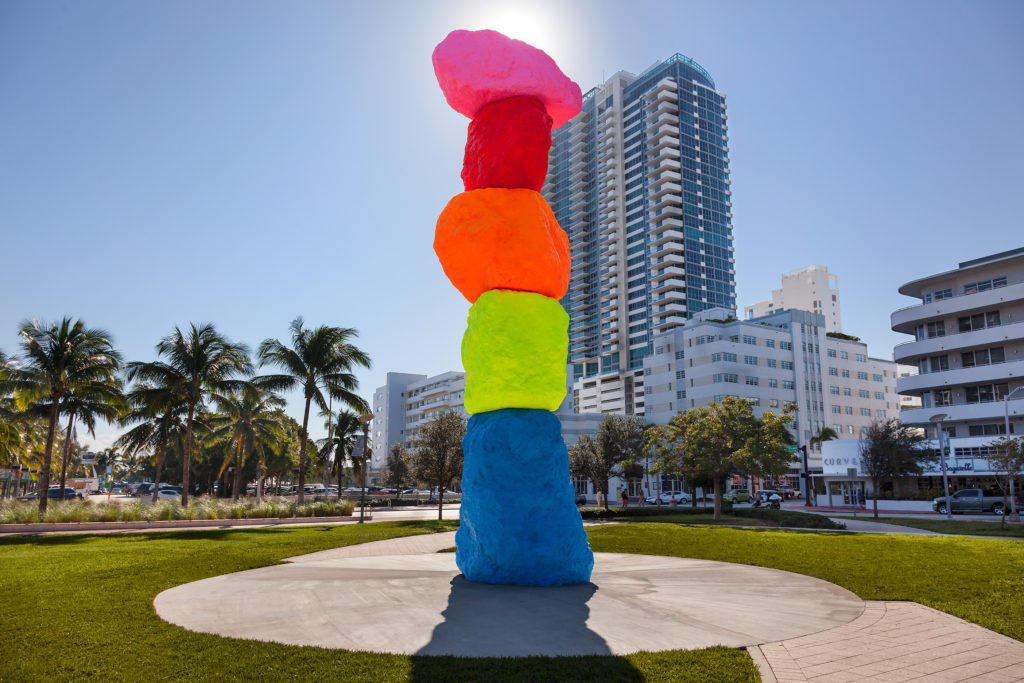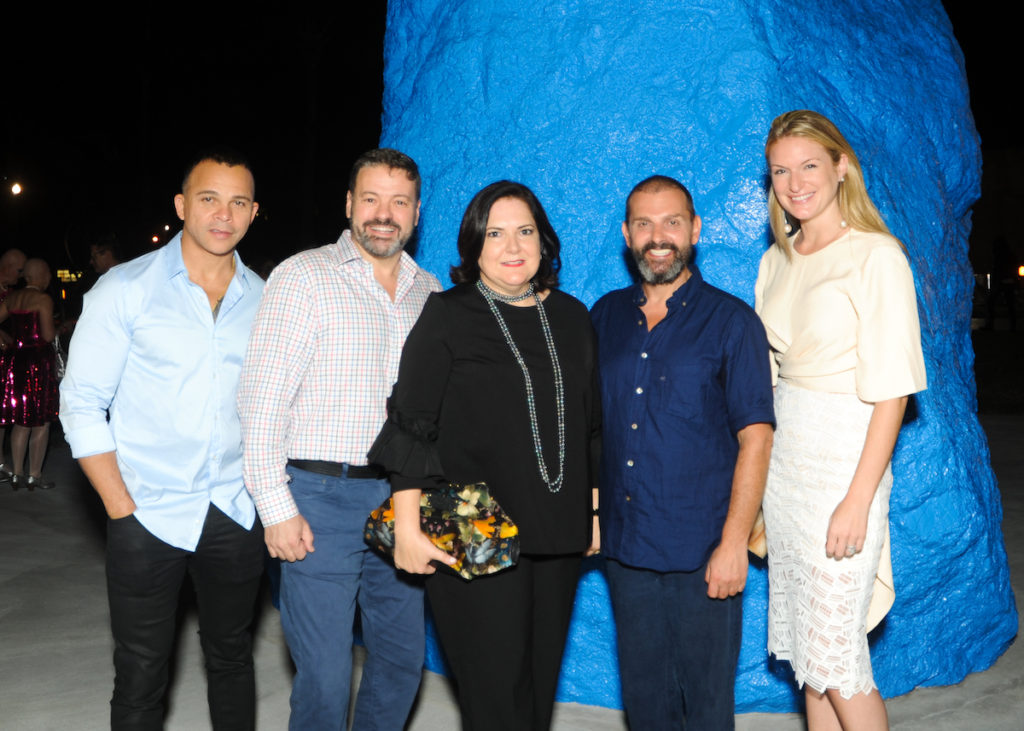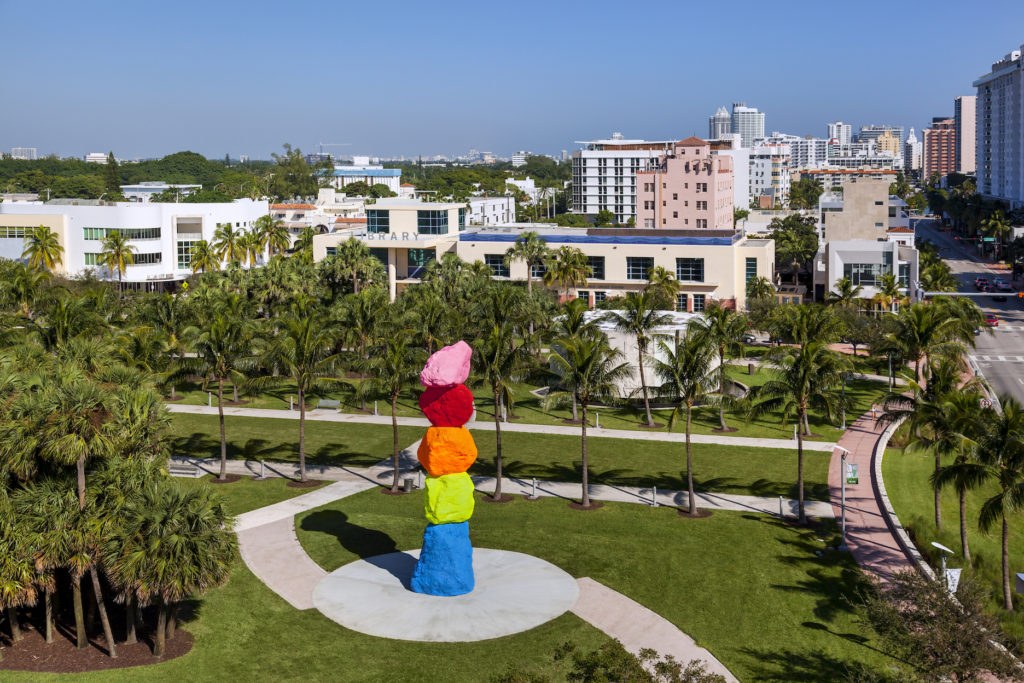
Ugo Rondinone, Miami Mountain, 2016, granite, paint, steel. Collection of The Bass Museum purchased with The John and Johanna Bass Acquisition Fund. Photo © Zachary Balber. Courtesy of The Bass, Miami Beach.
With a central placement at Collins Park in the foreground of the Bass Museum, Ugo Rondinone’s most recent edition to his series of stone sculptures appropriately titled “Miami Mountain” debuted during Art Basel Miami Beach, 2016. The sculpture, a totem of large-scale stones, appears to be precarious but is in fact extremely secure and has been installed with hurricane winds in mind. The museum has taken all precautions regarding the installation and nuanced weight and height of Rondinone’s work. Functioning as a playful interruption of the landscape, the piece stands out in the skyline intersected with buildings and palm trees. One of the unexpected elements of these works is that while at first appearing to be the ‘elephant in the room’ the sculptures are indeed the antithesis. Already extremely popular on Instagram, amongst those visiting Basel and the general public alike, “Miami Mountain” covers all its bases, satisfying art world echelons and those who just want to marvel at the colorful stones piled high.
This is the third iteration of this series within the last eight months. Variations first appeared in the desert two-hours outside of Las Vegas and then within the context of the gallery at Gladstone in New York and now the site-specific “Miami Mountain” has been permanently installed as part of new acquisitions of the Bass Museum. The exhibition at Gladstone Gallery titled “Ugo Rondinone: The Sun” ran from September through October of 2016 and featured smaller totems of colored rocks on molded cement plinths. In the desert, the exhibition titled “Seven Magic Mountains” opened in May 2016 and will be on view until 2018. In Miami, the totem stands 42 feet tall and is the first of the series to be part of a permanent collection to be displayed in public view. The piece also foreshadow’s Rodinone’s solo exhibition that will open at the Bass Museum in 2017.

Opening night ceremony of “Miami Mountain” at the Bass Museum with Silvia Karman Cubina (center) and Ugo Rondinone to her right with Sarah Arison and friends. Photo © Zachary Balber. Courtesy of The Bass, Miami Beach.
Currently closed for extensive renovations spearheaded by architect David Gauld along with Arata Isozaki who initiated the museum’s first major update in 2001, the Bass Museum of Art was founded in 1964. On the new acquisition of Rondinone’s sculpture, Executive Director Silvia Karman Cubiñá spoke with me at the inauguration of the sculpture stating, “The Bass Museum is really proud to own and present “Miami Mountain” and we couldn’t be happier that this selection also ushers in our acquisitions program. We have a ten-year initiative where we are going to be purchasing certain works of art and we really feel like we are starting out with a big bang.” Earlier in the day a group of over 200 school children had visited the sculpture and many little hands reached out to stroke the surface, taking selfies and even hugging the stones. Karman Cubiñá continued stating, “Because it’s in an urban environment people are contacting it in very different ways; getting off the bus, out of work, those who planned a specific trip to the museum as well as a lot of passersby and tourists who otherwise might not go to visit the museum. I really love that aspect of it and the diversity of experience it will bring to the area.”

Ugo Rondinone, Miami Mountain, 2016, granite, paint, steel. Collection of The Bass Museum purchased with The John and Johanna Bass Acquisition Fund. Photo © Zachary Balber. Courtesy of The Bass, Miami Beach.
Public sculpture has a way of doing just that, bringing people together. But not just ‘people’ as a plural form, often these sculptures can be interacted with even on the singular, personal level. Rondinone has been working with stone since his 2013 public installation in Rockefeller Plaza called “Human Nature.” This exhibition unbeknownst to the artist at the time was the inspiration for his current work. That body of work tapped into the artist’s interest in natural materials as well as his referencing humanity. Nine stone sculptures –not colored– in the shape of crude, rough-hewed human forms stood at varied heights and weighing up to 30,000 pounds each. A simulacrum of indigenous sculpture found deep in global deserts or minimally inhabited jungles, each tap into an underlying sense of spirituality or worship, becoming icons of the unknown. Speaking to Ugo Rondinone on “Miami Mountain” and this series of stone sculptures and whether he has plans to continue making more going forward the artist stated,
“The genesis of the work here was generated with the project I did in New York in 2013 at Rockefeller Plaza called “Human Nature” because it employed the same materials, stone, but in a raw state. Since it was in the middle of Rockefeller Center it was in the middle of the world, surrounded by development and technology so I wanted to bring in something very primitive and basic, such as these stone giants. At the same time the Nevada Museum and the Art Production Fund asked me to do something in the Nevada desert in which case I wanted to do the contrary bringing nature into nature, but I coated them aggressively with neon color. I killed the stone so people cannot really distinguish if it’s plastic, styrofoam, or stone. So this and all of my work builds up on duality. That’s the dynamic it employs.”
The Bass Museum will reopen to the public in spring 2017 and until then, “Miami Mountain” and other works on display in Collins Park can be visited whether purposefully or if you happen to be one of those people getting off a bus after work, accidentally.
Katy Diamond Hamer is the Founding Editor in Chief of Eyes Towards the Dove. She has been writing on contemporary art and culture since 2007. For more, follow her on instagram @katyhamer
